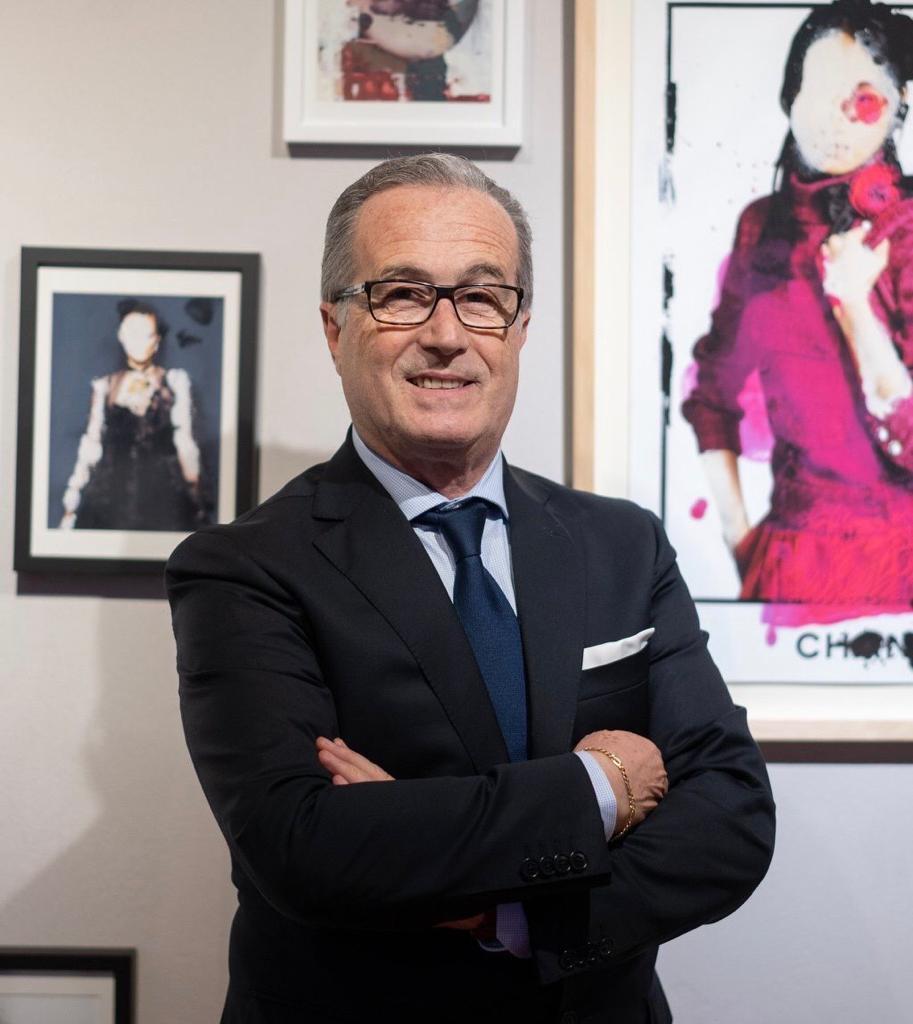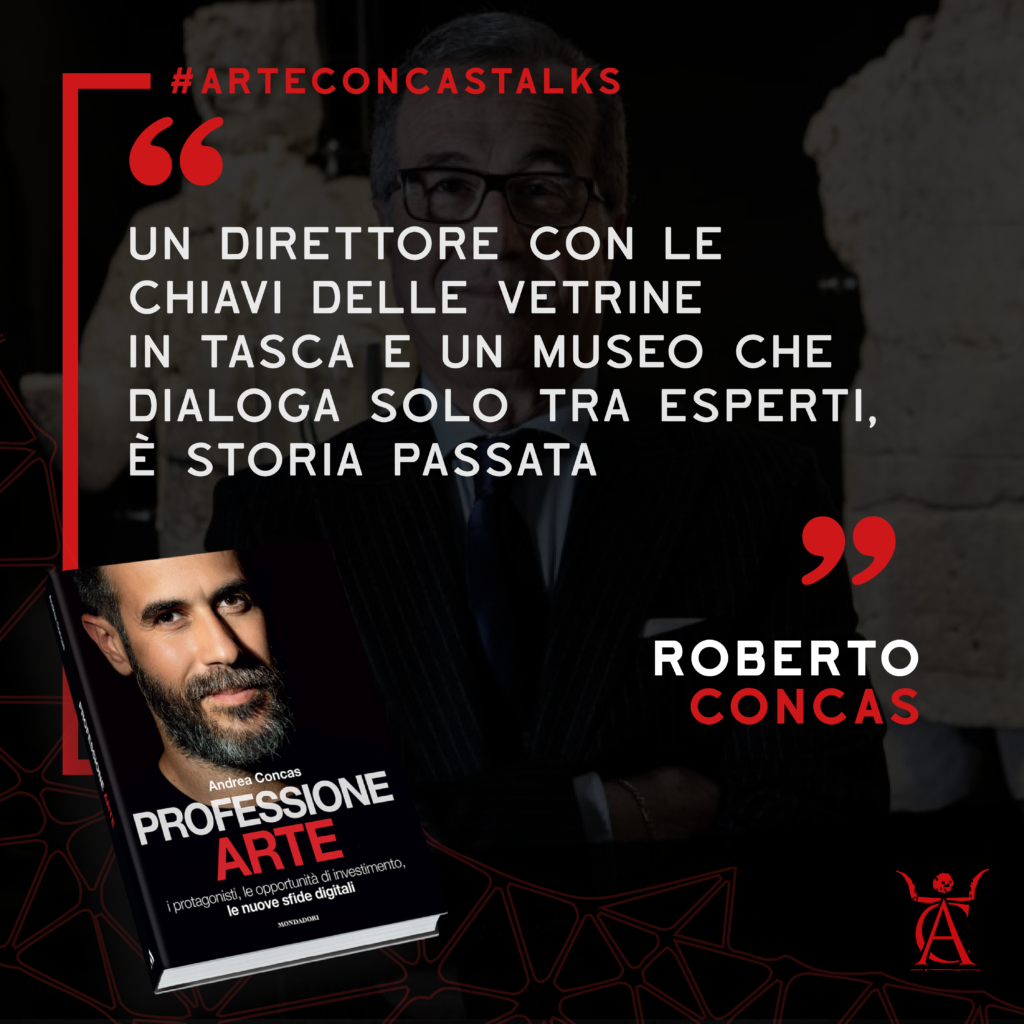The Interviews of ProfessioneArte.it
He is Roberto Concas, Art Historian, Museologist and Museum Systems Designer.
Five questions to know in advance the great art professionals, the daily challenges to face, the choices that have determined their path in the art system and in the art market, the digital changes and the advice for those who want to start the same career in collaboration with ProfessioneARTE.it.
“We, with many years of career, have the moral duty to break some mental schemes of the twentieth century, we owe it to young people so that they can better revolutionize the system“. It is with this will and spirit that Roberto Concas, Art Historian, Museologist and Museum System Designer approaches the future of art.
The new advances, of course, but digital thinking means, as he himself says, “developing and speeding up our neural synapses“ at the age of twenty when you start building your career, as well as after forty years spent designing, directing, collaborating and rethinking the organization of countless museums, exhibitions and publications.
The same approach, without formatting, has allowed him to conduct a thirty years long research, punctual and out of the box, which with determination has led to the discovery of a real deception warped by Leonardo da Vinci and to a wider and even more surprising extent to recognize a language of art … but we will read about this in the book to be published soon.
In this interview Roberto Concas voluntarily chooses not to give any advice to young people, but on the contrary he recognizes those essential characteristics that a future art professional learns in his path and they are all to be read…

Art Historian, Museologist, Designer of museum systems: this is Roberto Concas who until December 2018 was Director of the National Archaeological Museum of Cagliari of MiBACT.
Since the 1980s he has designed, directed and collaborated in the organization of countless exhibitions and publications, and is also the author of the book “Manuale Metodologico per Progettare un Museo”.
A researcher in art semiotics, he has interpreted a new writing system in works of art, expressed in the language of diagrammatic mathematics, which will be presented in a forthcoming volume entitled “L’inganno dell’Uomo Vitruviano – l’algoritmo della Divina Proporzione” (Giunti Editore) a study on drawing that reveals the deception warped by Leonardo da Vinci remained unsolved for 500 years.
Thanks to his experience of over 40 years in the Art sector, he supervises and deals with institutional relations with the public bodies of Art Rights and the procedures for the recognition of museum standards, management and enhancement.
1. How did your journey into the art world begin?
Pretty soon, practically in swaddling clothes.
In middle school I received a medal, in Rome in Campidoglio, as a prize for a painting, or something similar, and then the Liceo Artistico Statale, a real gym of life.
Back then, at the end of the 1960s, they were moments characterized by political discussion, but mainly cultural and artistic. Besides rock, pop and jazz music, photography and films like Blow-Up, we had a “Bible” written by Giulio Carlo Argan, four volumes full of art history and reflection, stimulated by a group of teachers of extraordinary stature.
It was in that “revolutionary” and independent environment, full of stimuli and lively discussions about art that I learned the “rebellion”, to stay out of the group logic, looking for my way.
I have never been an artist because my mind was running faster than my hand, and then I was, and am, intolerant of superficially imposed discipline, while being very disciplined and rigorous in doing my work for art and museums.
Choices pay off, but they pay off, so I don’t regret it.
From High School to University, a leap into “Paradise”, few people at that time studied Art History with the help of rare publications with strictly black and white images.
Then the profession, the Ministry of Cultural Heritage, exhibitions, museum management, the role of freelancer, teaching at university, study, research, business, restoration and then museums and museums again, from theory, idea, design, implementation and management.
2.How would you describe your profession today?
I’m a continuous experimental yard professional, trying to live a “rebellious maturity” and intolerant of clichés where: “graceful figures hover in the space of feelings”.
For over a hundred years now the figures have been “hovering”.
We, with many years of career, have the moral duty to break some mental schemes of the twentieth century, we owe it to young people so that they can better revolutionize the system.
However, the new always advances with the old: it is in this spirit that after more than thirty years of study I came to the end of a research, conducted in the semiotics of art, which led me to reveal “the deception of Leonardo da Vinci’s Vitruvian man”.
And… anticipating the possible observations, I specify that it was an important but accidental discovery, while I was looking for something else, a condition that Horace Walpole has defined: serendipity.
In the meantime I have learned, with the semiotics of art, to enter, participate in and leave the scene of a painting as if it were an architectural space, following the signs left by artists as a trace of their language, writable, legible and iterable, expressed in the diagrammatic form of mathematics, a language initially handed down for centuries in the workshops.
And last but not least, I entered the mystery of art where, as Umberto Eco writes: […] The artist works humbly under the inspiring breath of the Holy Spirit; without this inspiration he could not even attempt to work. […].
This is the strongest emotion, if we want to be secular and mathematically demonstrable, which I wish everyone.
3. How has your profession changed over time?
In the first years of my professional activity I left a business card with the words “Art Historian – Museologist” on it, whoever received it observed it with careful distrust, asking me immediately what was this profession? Is there a register? Who are you?
Today, we can give our business card without receiving any questions.
Rather, there remain some confusion of roles, tasks, functions and specializations.
An art critic, an anthropologist, an ethnomusicologist, an ethnomusicologist, an archaeologist, an architect, a geologist, I am not necessarily also a museologist or an exhibition organizer, to each his own!
Professions are such when they are specialized and not generalized!
So, as the philosopher Ludwig Wittgenstein writes: “On what one is unable to speak, one must be silent“.

4. What sort of impact is digital having on your profession?
I would say still low in thought and methodology, just a little higher in the daily use of instruments, but far from what is correctly called an innovative Digital Humanities.
Thinking digital does not mean filling museums with computers or going on social networks, but using a method of knowledge closer to that of mind maps which, digitally and in a synchronic and multidisciplinary way, allow access to knowledge and communication.
It means developing and speeding up our neural synapses with computer systems and Artificial Intelligence, in order to better understand our world and hypothesize a better future.
Without the digital world I would perhaps never have been able to discover the oldest rules of the Divine Proportion encrypted by Leonardo in his famous drawing.
On the web and in the digital method I was able to consult texts, contents and images in an extraordinarily impressive and comparative number, a work that was literally impossible to do in the library or archives.
5. What would you recommend to a young man who wants to take up his profession?
The streets of personal and interpersonal failure are paved with good, unsolicited advice, so I haven’t given any for a long time!
But I see too many young people “formatted” and not already formatted!!! But it’s not always their fault!
However, I know for sure that beyond the constant and consistent commitment, it is necessary to put together the passion, and choose the right masters.
You mustn’t be too afraid to fail and always try and try again.
Moreover, it is essential to be eclectic, able to put together more information and conditions, following precisely the scheme of mental maps.
This does not mean doing a bit of everything, and badly, it means doing a certain and precise activity by linking and combining more information and experiences.
You can’t understand art if you haven’t soiled your hands with paint, linseed oil and turpentine, and if you’ve never carried a painting on an Apecar, but that’s not dogma, it’s also worth knowing how to change a RAM card, repair an electrical outlet or write a binary code:
01010010 01101111 01100010 01100101 01110010 01110100 01101111 00100000 01000011 01101111 01101110 01100011 01100001 01110011






